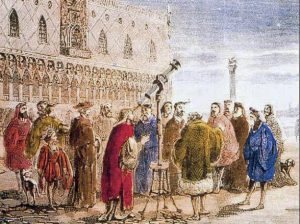 The Scientific Revolution emerged through new developments in mathematics, physics, astronomy, biology, and chemistry, transforming our understanding of the natural world. It began in Europe towards the end of the Renaissance period (14th-16th centuries), marking the end of the Middle Ages.
The Scientific Revolution emerged through new developments in mathematics, physics, astronomy, biology, and chemistry, transforming our understanding of the natural world. It began in Europe towards the end of the Renaissance period (14th-16th centuries), marking the end of the Middle Ages.
The revolution emerged following the publication of De revolutionibus orbium coelestium by Nicolaus Copernicus in 1543, followed by the Dialogue Concerning the Two Chief World Systems (illustrated left) by Galileo Galilei.
Scientific Method
The first known use of the scientific method’s falsification testing is documented in I Kings in chapter eighteen. After flooding water on a wood sacrifice, Elijah called out –
“The Lord sent fire down, and it burned up the sacrifice, the wood, and the stones, scorched the earth, and dried up the water in the trench.”
Using scientific methods, Copernicus and Galileo demonstrated that the Sun is at the center of our solar system (heliocentrism), not the Earth, as ancient Greek philosophy reasoned (geocentricism). The findings revolutionized our understanding of the universe, contradicting the traditions of the Roman Catholic Church. Ancient Greek and Roman philosophers, including Aristotle and Ptolemy, taught that reason and logic could unlock all of nature’s mysteries.
However, Copernicus and Galileo upended centuries of logical but erroneous teachings using the scientific method. The emergence of the Scientific Revolution coincided with the Protestant Reformation, launched by Martin Luther’s Ninety-five Theses in 1517.
The Scientific Renaissance ended in 1687 with Isaac Newton‘s publication of the laws of motion and universal gravitation in Philosophiæ Naturalis Principia Mathematica, Latin for Mathematical Principles of Natural Philosophy, best known as Principia. Newton’s principles synthesized a scientific understanding of our universe. The Scientific Revolution sought to understand nature’s mysteries. As noted by King Solomon,
“It is the glory of God to conceal a matter, But the glory of kings is to search out a matter.”
Scientific Revolutionaries
The founder of nearly every scientific disciple today ascribed to Judeo-Christian principles. Listed below, in the order of their date of birth, are their names and years. To view, click on the names below –
Nicholaus Copernicus, 1473
John Napier, 1550
Francis Bacon, 1561
Galilei Galileo, 1564
Johannes Kepler, 1571
Blaise Pascal, 1623
Robert Boyle, 1627
John Ray, 1627
Nicholas Stenonius, 1631
Isaac Newton, 1642
John Woodward, 1665
Benjamin Franklin. 1706
Leonhard Euler, 1707
Carolus Linnaeus, 1707
William Herschel, 1738
David Brewster, 1781
Michael Faraday, 1791
Samuel F.B. Morse, 1791
Charles Babbage, 1792
John Herschel, 1792
Joseph Henry, 1797
Matthew Maury, 1806
Louis Agassiz. 1807
James Simpson, 1811
James Joules, 1818
George Stokes, 1819
Gregor Mendel, 1822
Louis Pasteur, 1822
Henri Fabre, 1823
Lord William Thomson Kelvin, 1824
Bernhard Rieman, 1826
Joseph Lister, 1827
James Clark Maxwell, 1831
Lord Rayleigh, 1842
Nikola Tesla, 1856
Max Planck, 1858
Albert Eisenstein, 1879
Scientific Revolution is a site Cornerstone pillar.
Darwin Then and Now is an educational resource on the intersection of evolution and science, highlighting the ongoing challenges to the theory of evolution.
-
- Understanding Evolution showcases how varying historical study approaches to evolution have led to varying conclusions. Subcategories include –
- Studying Evolution explains how key evolution terms and concepts have changed since the 1958 publication of The Origin of Species.
- What is Science explains Charles Darwin’s approach to science and how modern science approaches can be applied for different investigative purposes.
- Evolution and Science feature study articles on how scientific evidence influences the current understanding of evolution.
- Theory and Consensus feature articles on the historical timelines of the theory and Natural Selection.
- The Biography of Charles Darwin category showcases relevant aspects of his life.
- The Glossary defines terms used in studying the theory of biological evolution.
- Understanding Evolution showcases how varying historical study approaches to evolution have led to varying conclusions. Subcategories include –


